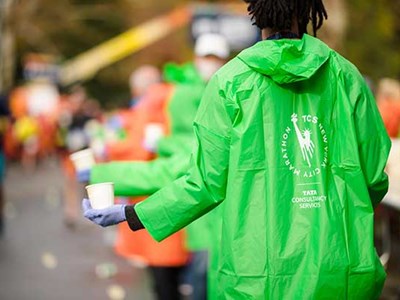Warm-Weather Running Guidelines

As heat and humidity increase, so too do the risks of heat-related medical issues. Review the following guidelines from NYRR, and stay safe during your warm-weather training runs and races.
• Respect your limits. Heat and humidity increase the physical challenge of running, and health problems can occur when you push beyond what your body can handle. Do not aim for a personal best on a warm, sticky day, particularly if you are not used to such conditions.
• Acclimate. It takes 10 days to two weeks for the body to acclimate to keeping cool at higher temperatures. Give your body time to adjust.
• Know the signs of heat problems. If you feel faint, dizzy, disoriented, or your skin is clammy and abnormally hot or cold, slow down or stop running. If symptoms continue, sit or lie down in the shade and seek medical help.
• Drink enough. Drink throughout the day, so that your urine remains plentiful and pale yellow. Even mild dehydration (scant, dark-yellow urine) will make you feel sluggish and tire early during exercise, and can increase the risk of heat-related problems during exercise. In the heat, sports drinks are sometimes even better than plain water because the sugar and salt they contain can better help you to stay hydrated. Before workouts or races lasting longer than one hour in the heat, drink 16 ounces of fluid several hours in advance, another 16 ounces in the hour before, and more just before the start if your urine isn't pale.
• Don't drink too much. Overhydrating before and during exercise can cause a dangerous condition known as hyponatremia (water intoxication). This drop in the body's sodium levels can cause nausea, fatigue, vomiting, weakness, and in the most severe cases, seizures, coma, and death. To avoid hyponatremia, do not overdrink, include pretzels or a salted bagel in your pre-run meal, and use a sports drink that contains sodium. During exercise, drink no more than a cup of fluid every 15 to 20 minutes.
• Eat a good pre-race meal a few hours before the run. Try a bagel with peanut butter and a banana—the protein and carbs will fuel your effort and aid in recovery.
• Consume salt. Eat salted foods like a salt bagel, salted pretzels, or salted nuts. If you’re planning to race, eat salted foods all week prior to the event. On race day, consume one fast-food salt packet at the start line. Have another salt packet halfway through the race.
• Protect yourself from the sun. Wear a cap or visor to shield your head, face, and eyes from the sun’s burning rays, and wear sunglasses to protect your eyes. Use sunscreen on exposed skin, even on overcast days.
• Check your meds. Do not consume products like cold medicines, ephedrine, pseudoephedrine, or anti-diarrhea medicines with dehydrating agents in them. They may increase your risk for heat illness. Caffeine products are only OK in doses you are used to taking on training day. Do not start taking a caffeine product on race day.
• Wear synthetic fabrics. Unlike cotton, synthetics wick moisture from your skin so cooling evaporation can occur. Synthetics also decrease chafing and don't cling and cause a chill. Look for loose-fitting garments with mesh inserts under the arms, on the sides of the torso, down the arms, and on the outer thighs. Acrylic socks keep feet dry and cool.
• Use water along the course (cups, spray stations) to cool yourself during races. If you are overheating, a cool spray will cool you down quickly and have a lasting effect as the water evaporates from your skin. Keep in mind, though, that drenched clothing will cling to skin and prevent evaporation, and wet socks can cause blisters, so use this strategy wisely.
Event Alert System
NYRR has implemented a color-coded Event Alert System (EAS) for our races that will communicate the status of course conditions on race day. The levels range from Low (green) to Moderate (yellow) to High (red) to Extreme (black) based on the weather and other course conditions. On race day, the current EAS status will be communicated via color-coded flags at the start and finish areas and along the course at each medical station.
All participants should familiarize themselves with the EAS prior to the race, remain alert for directions from race officials, and take precautions to prepare properly for varying weather or course conditions on race day.
Scroll on mobile to see more.
| Alert Level | Event Conditions | Recommended Actions |
|---|---|---|
| Extreme | Event cancelled / Extreme and dangerous | Participation stopped / Follow event official instruction |
| High | Potentially Dangerous | Slow down / Observe course changes / Follow event official instruction / Consider stopping |
| Moderate | Less Than Ideal | Slow down / Be prepared for worsening conditions |
| Low | Good | Enjoy the event / Be alert |